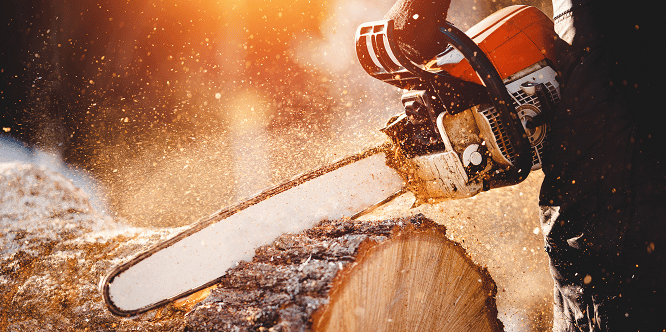TAKEAWAY: The forestry and agriculture industry is a high-risk sector for occupational noise-induced hearing loss (ONIHL). This article explores the risks for NIHL in forestry and agriculture and what employers can do to minimize them.
Jump Ahead
Noise-induced hearing loss (NIHL) is one of the most prevalent work-related health problems. Occupational noise-induced hearing loss (ONIHL) is the term used for NIHL in the work setting, and the dangers of NIHL are more significant for workers in specific industries. The forestry and agriculture industry is one of these sectors, so this article explores the risks for NIHL in forestry and agriculture and what employers can do to minimize these risks.
NIHL can also occur outside the work setting. ONIHL is more common and serious because of its prolonged duration. Any type of NIHL, whether occupational or not, is permanent and irreversible. Employers can avoid or minimize the risk of NIHL in workers and prevent further damage in cases where NIHL is already evident.
This article is the third in a five-part series highlighting the risk of NIHL in various industries and offering action tips for employers. Read on to learn about NIHL risks in the forestry and agriculture industry and how to reduce them.

Book an Appointment Today!
SureHire’s audiometric testing services allow you to detect NIHL before it becomes a problem, providing you with the information you need for investigation and intervention so you can protect your workforce.
What does the research say about NIHL in the forestry and agriculture industry?
The National Institute for Occupational Safety and Health (NIOSH) highlighted a 2018 study indicating around 25% of all US workers have been exposed to hazardous noise, and approximately 12% have hearing difficulty.
Occupational hearing loss is a widespread problem. The following studies highlight findings relevant to the forestry and agriculture industry to better understand the risks in this sector compared with others.
An analysis of the Occupational Safety and Health (OSHA) Integrated Management Information System (IMIS) database across more than 30 years showed a high prevalence of noise in the forestry and agriculture industry. Regarding permissible exposure limit (PEL) for noise, the agriculture, forestry, fishing, and hunting sector had the highest mean noise levels.
Another study analyzed the audiograms of 1.4 million noise-exposed US workers, including over 17,000 in the agriculture, forestry, fishing, and hunting (AFFH) sector. The results indicated a slightly lower prevalence of hearing loss in AFFH (15 percent) compared with all other industries combined (19 percent).
However, many of the AFFH sub-sectors exceeded this prevalence. The forestry sub-sector was the highest. Forest Nurseries and Gathering of Forest Products was particularly high at 36 percent, and Timber Tract Operations came in at 22 percent.
Although industries like mining and oil and gas frequently show up in research studies as the highest-risk industries for NIHL, it’s clear that forestry and agriculture have significant NIHL risks.
Noise risks in the forestry and agriculture industry
Loud sounds can cause NIHL, either from a single loud blast or prolonged exposure. Sound sources in the forestry and agriculture industry that could cause hearing loss include the following:
- Chainsaws
- Tractors
- Silage blowers
- Forage harvesters
- Grain dryers
- Skid-steer loaders
- Guns
OSHA’s standard for acceptable noise exposure is 90 A-weight decibels dB(A) across an eight-hour work day. Sounds in agriculture and forestry will fall somewhere in a range of values, several of which will likely be higher than recommended levels if a worker is exposed to them all day.
For example, in farming, tractor noise will likely be between 74 and 112 dB(A). Noise from grain dryers is between 81 and 102 dB(A). Impact noise, such as gun firing, will be much higher but cannot exceed 140dB(A).
In forestry, high-noise tasks include unlatching cables that hold and move logs (92 dBA) and using chainsaws (91-110 dBA).
How forestry and agriculture employers can minimize the incidence of NIHL in the workplace
Employers in the forestry and agriculture industry can take several steps to help reduce the incidence of ONIHL. The main action points are below.
Reduce noise exposure duration
When noise levels exceed acceptable standards across an eight-hour work day, employers must reduce the exposure duration accordingly. For example, at a sound level of 95dB(A), four hours is permissible, and at 115dB(A), 15 minutes is allowable over a day. Employers should use a job rotation strategy to ensure employees don’t spend too much time on noisy tasks.
Employers should recognize that employees are also exposed to hazardous noise outside the workplace, and individual variability means that some individuals are more noise-sensitive than others. Therefore, it’s vital to take a conservative approach to help protect workers.
Invest in quieter, modern equipment and keep it maintained
Newer equipment models are helping to tackle the problem of noise-induced hearing loss. Employers can invest in quieter equipment or modify existing equipment to help protect workers’ hearing.
Examples in agriculture include:
- Invest in tractors and skid-steers with enclosed sound-proof cabs to reduce operator noise exposure. Older tractors can be around 6dB louder than new tractors, and cabs reduce noise by approximately 16dB.
- To tractors, employers can add other noise-reducing materials such as soft foam or fibreglass.
- Ensure air compressors have mufflers and exhausts have silencers.
- Invest in modern equipment designed to be quieter, such as flexible mountings on modern leaf blowers and chainsaws.
- Use isolation materials such as rubber mounts and air cushions to reduce vibrational noise from equipment.
- Adhere to a regular maintenance schedule for tools and engine systems to replace worn-out parts and keep equipment lubricated.
- Keep non-essential noise, such as noise from a radio (which can add around 3-5dB of extra noise to tractor cabs), to low levels.
- Pin up signs to show the areas where hearing protection is required.
Use hearing protection
Any worker exposed to noise above 85dB(A) should use hearing protection. It’s a vital way to protect workers in the forestry and agriculture industry. Hearing protection is often misused, so employers must understand how to choose the most appropriate hearing protection and help employees to understand the importance of proper use. Employers can choose earmuffs or custom-moulded earplugs to protect their workers.
Audiometric testing
Employers in high-risk industries for noise exposure (such as those in the forestry and agriculture industry) should conduct audiometric testing on all workers. Baseline and periodic hearing tests can identify early signs of NIHL so employers can take action to protect workers from further damage.

Book an Appointment Today!
SureHire’s audiometric testing services allow you to detect NIHL before it becomes a problem, providing you with the information you need for investigation and intervention so you can protect your workforce.
You May Also Be Interested In…
- Do You Have Reasonable Suspicion?
 Employers cannot initiate reasonable suspicion testing without first going through the 5-step process. Reasonable suspicion training provides critical information about how to initiate reasonable suspicion testing, including the 5-step process and other tools that employers can use to help manage the misuse of alcohol and drugs in the workplace.
Employers cannot initiate reasonable suspicion testing without first going through the 5-step process. Reasonable suspicion training provides critical information about how to initiate reasonable suspicion testing, including the 5-step process and other tools that employers can use to help manage the misuse of alcohol and drugs in the workplace. - An Employer’s Guide: What You and Your Employees Need to Know About DOT Drug & Alcohol Testing
 When implementing or maintaining DOT Drug & Alcohol testing, there are key areas that employers should consider.
When implementing or maintaining DOT Drug & Alcohol testing, there are key areas that employers should consider. - SureHire Occupational Testing Acquires COHR Health: A Positive Step Towards Safe, Healthy, Productive Workforces and Communities
 We are thrilled to announce that today, May 6, 2024, SureHire Occupational Testing has officially acquired COHR Health, a well-known leader in occupational health services. Read on…
We are thrilled to announce that today, May 6, 2024, SureHire Occupational Testing has officially acquired COHR Health, a well-known leader in occupational health services. Read on… - Occupational Testing Use Case – Mining
 In this case study, we will explore how mining companies can use various types of occupational tests to reduce Total Recordable Incident Rates (TRIR) long term.
In this case study, we will explore how mining companies can use various types of occupational tests to reduce Total Recordable Incident Rates (TRIR) long term. - 9 Strategies to Keep Workers Cool on Drilling Sites During Hot Summer Months
 This article delves into strategies to keep workers cool and safe on drilling sites during the hot summer months.
This article delves into strategies to keep workers cool and safe on drilling sites during the hot summer months. - Hearing Conservation Basics: How to Manage Occupational Noise
 Learn how to proactively mitigate occupational noise risks and help prevent NIHL among workers.
Learn how to proactively mitigate occupational noise risks and help prevent NIHL among workers.

